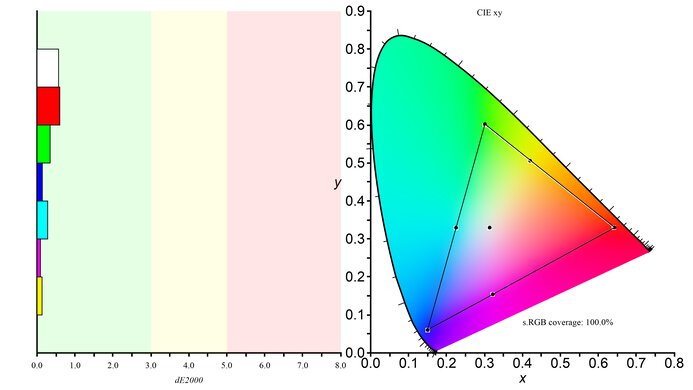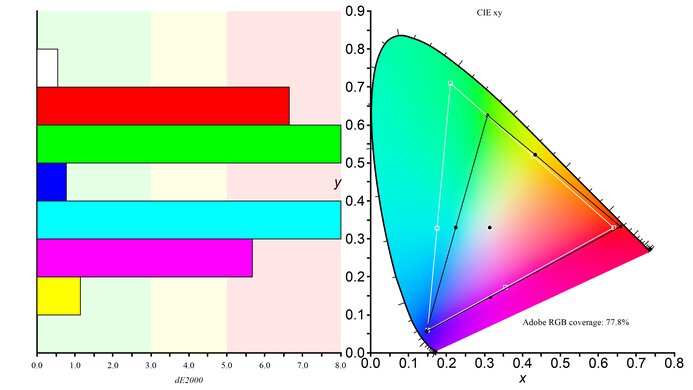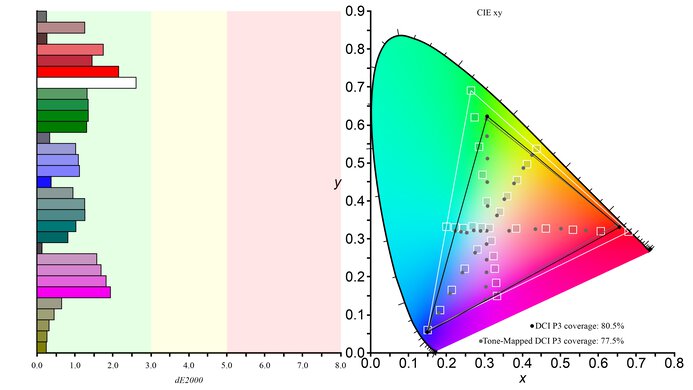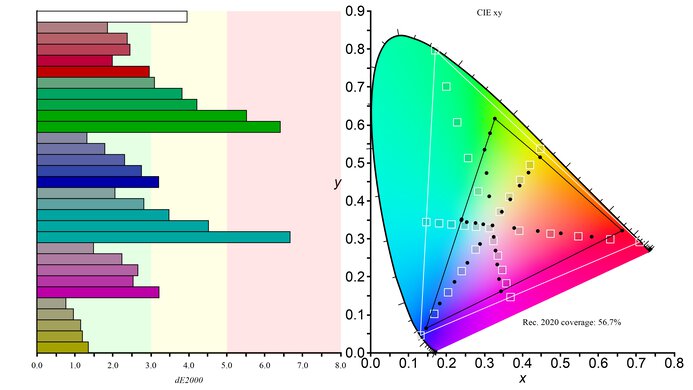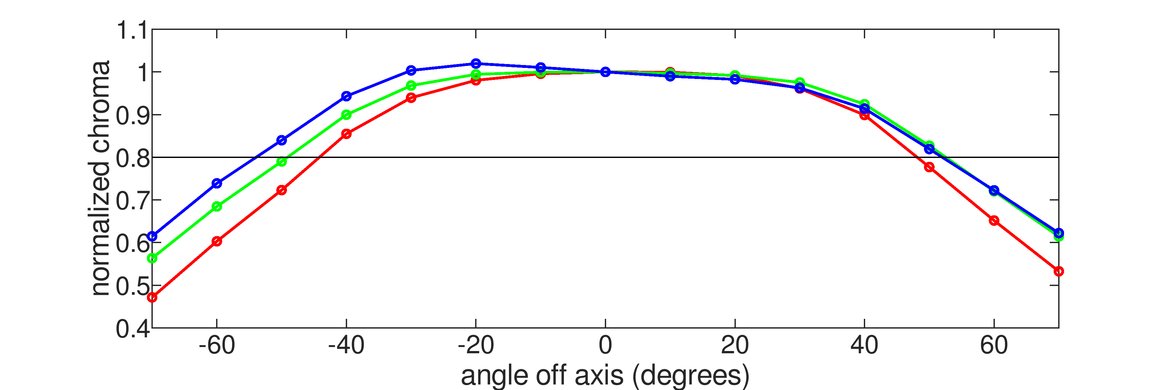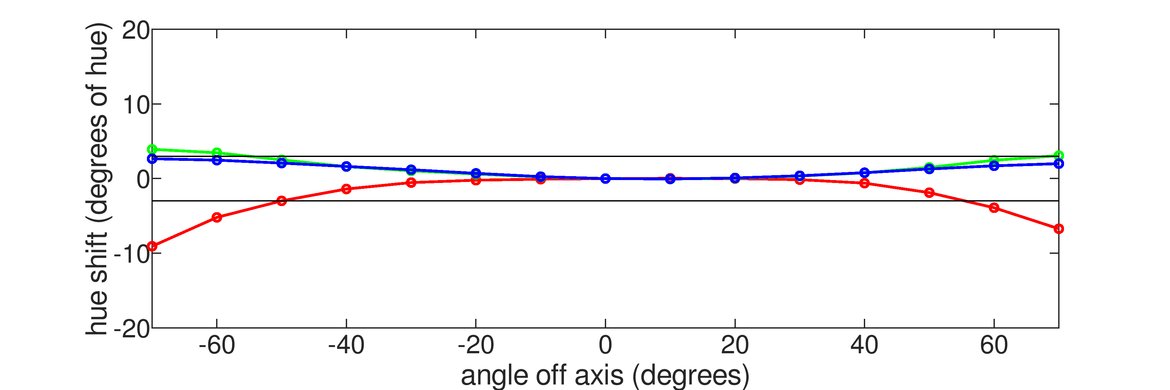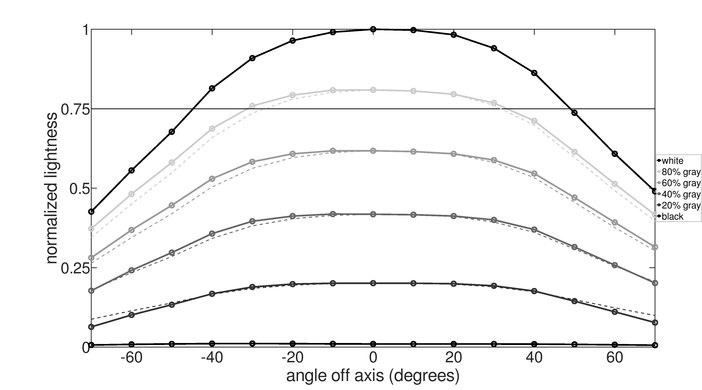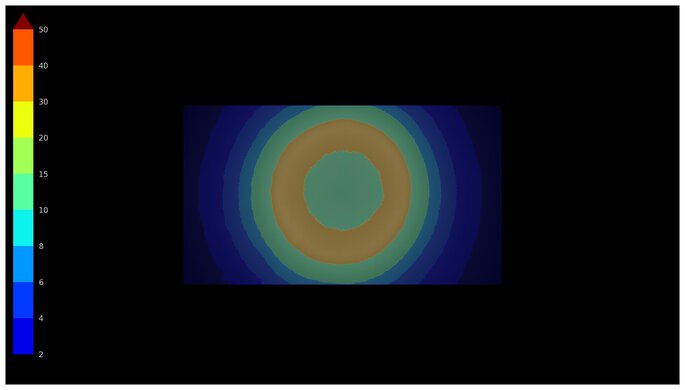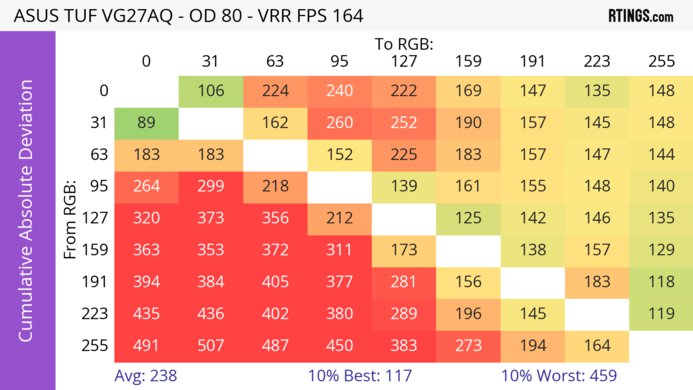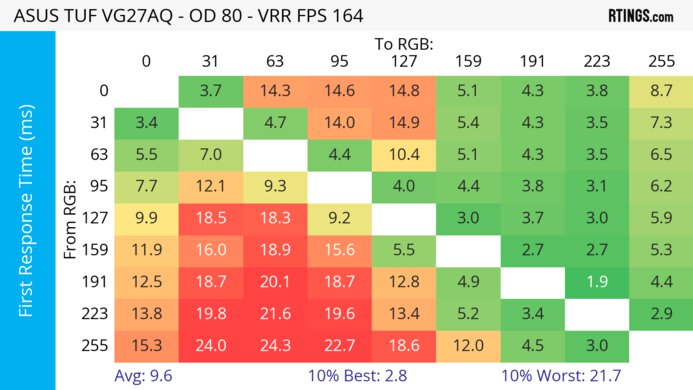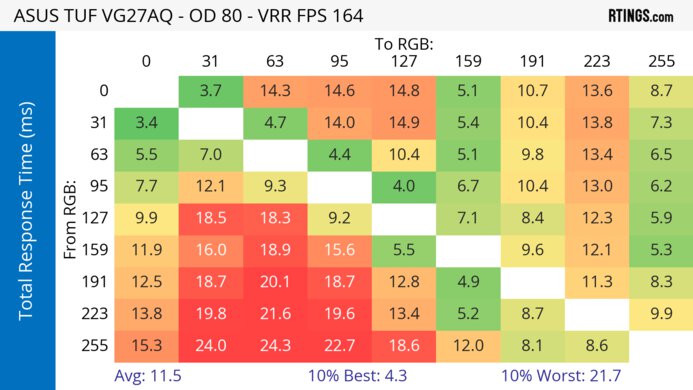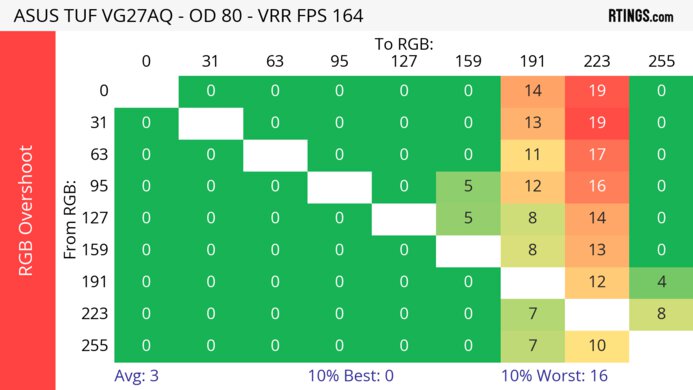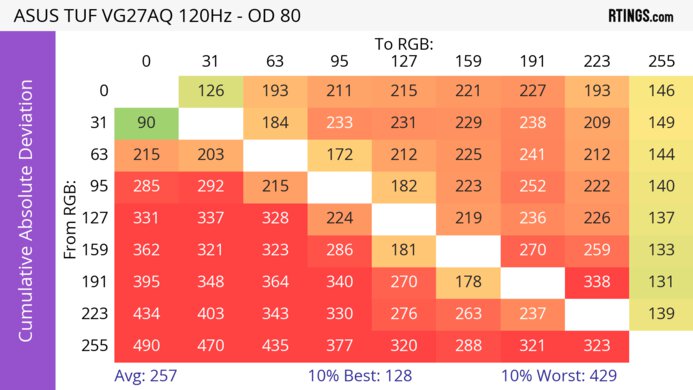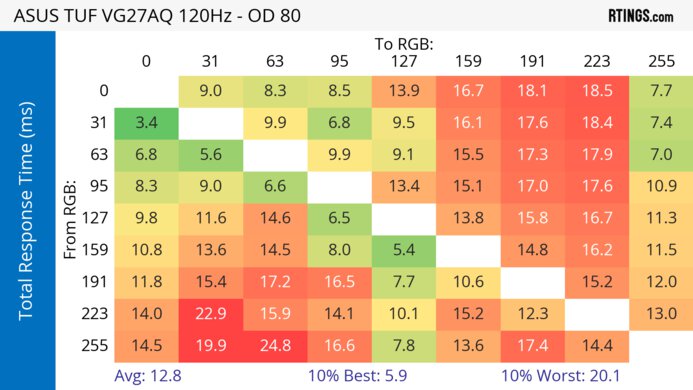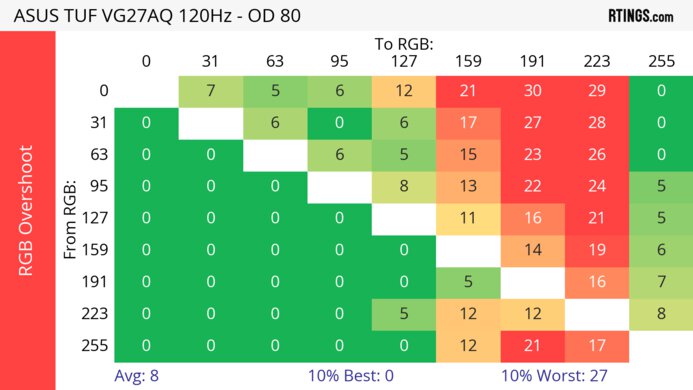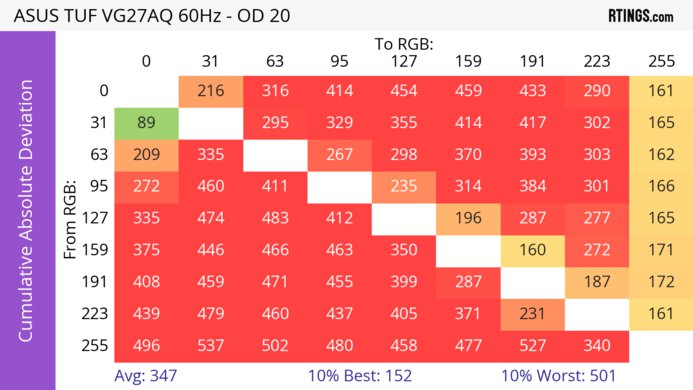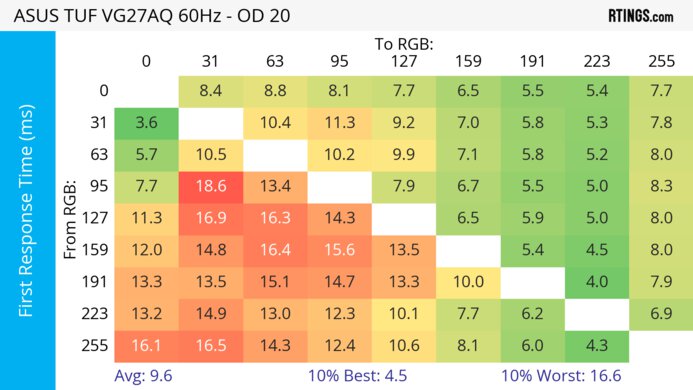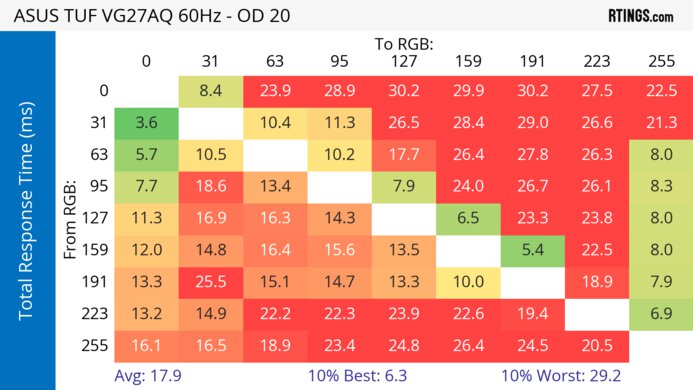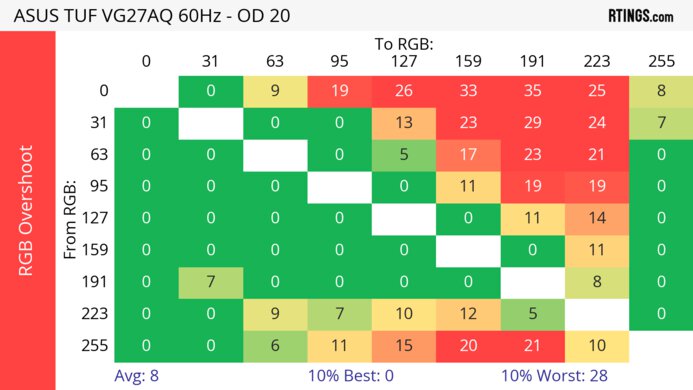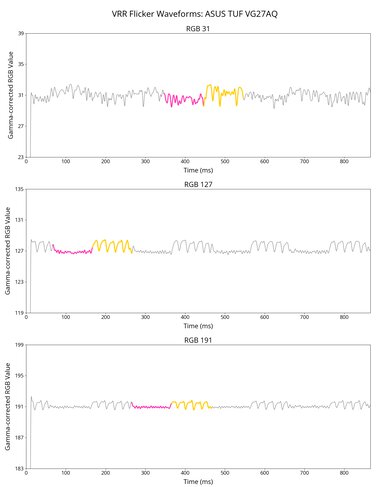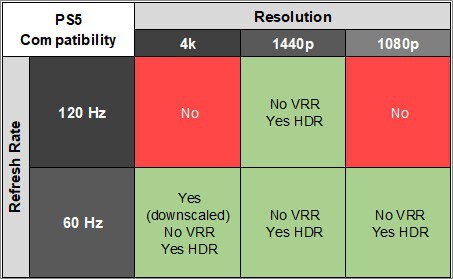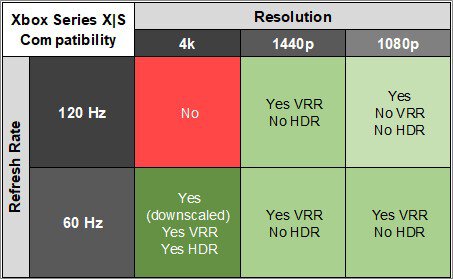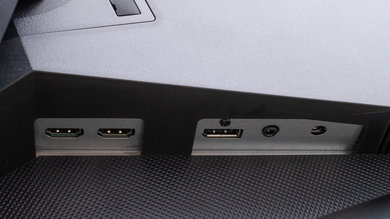The ASUS TUF VG27AQ is a popular entry-level 27-inch, 1440p gaming monitor that first came out in 2019. It has a native 144Hz refresh rate that you can overclock to 165Hz, and it has G-SYNC compatibility to reduce screen tearing. It also comes with ASUS's ELMB Sync technology to reduce persistence blur, but it's limited in many extra features as it doesn't have a USB hub. It competes with many other budget-friendly 1440p gaming monitors. Keep in mind that there's also a newer model, the ASUS TUF Gaming VG27AQL1A, that you can find available.
Our Verdict
The ASUS TUF VG27AQ is okay for PC gaming. While it has VRR support to reduce screen tearing and low input lag for a responsive feel, motion is blurry as it has a slow response time. It also has limited quality with a low contrast ratio that makes blacks look gray, and no local dimming feature to improve it.
- 165Hz refresh rate with VRR support.
- Low input lag.
- Blurry motion at any refresh rate.
- Low native contrast ratio.
The ASUS TUF Gaming VG27AQ is disappointing for console gaming. It can't take full advantage of the PS5 and Xbox Series X|S, and fast-moving objects are blurry, especially at lower refresh rates. It also can't deliver life-like images as it has a low contrast ratio and fails to make colors look vivid. On the plus side, it has low input lag for a responsive feel.
- Low input lag.
- Blurry motion at any refresh rate.
- Low native contrast ratio.
- Lack of HDMI 2.1 bandwidth.
The ASUS TUF VG27AQ is a good monitor for office use. Thanks to the fantastic ergonomics, you can easily share your work with a colleague, and the wide viewing angles ensure everyone enjoys the same consistent image from the sides. It can get fairly bright to combat glare in most rooms, but it struggles with reflection handling. However, it's limited in extra features, as it doesn't have a USB hub.
- Bright enough to fight glare.
- Fantastic ergonomics.
Distracting reflections.
- Lack of extra features like a USB hub.
The ASUS TUF VG27AQ is a decent monitor for content creation. Its fantastic ergonomics make it easy to place comfortably, and its wide viewing angles allow you to collaborate with a colleague sitting next to you. However, it has limited picture quality, especially in dark rooms, and while it has good accuracy before calibration, you still need to calibrate it for the best accuracy.
- Bright enough to fight glare.
- Fantastic ergonomics.
Distracting reflections.
- Low native contrast ratio.
- No local dimming feature.
- Still need calibration for best accuracy.
- Lack of extra features like a USB hub.
The ASUS TUF Gaming VG27AQ has okay brightness. It gets bright enough to fight glare in most well-lit rooms, but highlights don't pop in HDR.
- Bright enough to fight glare.
- Highlights don't pop in HDR.
The ASUS TUF Gaming VG27AQ has a disappointing response time. There's motion blur and noticeable inverse ghosting with fast-moving objects, especially at lower refresh rates.
- Blurry motion at any refresh rate.
The ASUS TUF Gaming VG27AQ has poor HDR picture quality. It has a low contrast ratio, and without a local dimming feature, blacks look gray in dark rooms. It also can't display a wide range of vivid colors.
- Low native contrast ratio.
- No local dimming feature.
The ASUS TUF Gaming VG27AQ has okay SDR picture quality. While it displays a wide range of colors, it has a low contrast ratio, so blacks look gray in dark rooms.
- Displays wide range of colors.
- Low native contrast ratio.
The ASUS TUF Gaming VG27AQ has great color accuracy. While it doesn't have a dedicated sRGB mode, it still has good accuracy before calibration. That said, calibrating it results in the best accuracy.
- Good accuracy before calibration.
- Still need calibration for best accuracy.
Performance Usages
Changelog
- Updated Nov 10, 2025: We've converted this review to Test Bench 2.1.1. We removed the Vertical Viewing Angle test.
-
Updated Jul 24, 2025:
We updated text throughout to match the new and updated tests with Test Bench 2.1, including in the Verdict section.
- Updated Jul 21, 2025: We've converted this review to Test Bench 2.1. This includes new tests for Direct Reflections, Ambient Black Level Raise, and Total Reflected Light. You can see all the changes in the changelog.
- Updated Feb 21, 2025: We've converted this review to Test Bench 2.0.1. This includes a new test result for DisplayPort 2.1 Transmission Bandwidth.
Check Price
Differences Between Sizes And Variants
We tested the 27-inch ASUS VG27AQ, which is the only size available for this model. There are other TUF Gaming models available with a similar name, including the newer ASUS TUF Gaming VG27AQL1A, but they perform differently, and the results are only valid for this monitor.
| Model | Size | Resolution | Max Refresh Rate | Panel Type |
| VG27AQ | 27" | 1440p | 165Hz | IPS |
The unit we reviewed was manufactured in July 2019, and you can see the label here.
Popular Monitor Comparisons
The ASUS VG27AQ is an okay PC gaming monitor that was popular when it first came out in 2019, but it's since been outperformed by newer budget-friendly 1440p gaming monitors, like the Dell G2724D. Unfortunately, even the newer ASUS TUF Gaming VG27AQL1A isn't much of an upgrade in terms of performance over this monitor, so there are better options elsewhere.
See also our recommendations for the best monitors, the best gaming monitors, and the best 1440p gaming monitors.
The ASUS TUF Gaming VG27AQL1A and the ASUS TUF VG27AQ perform very similarly. The VG27AQL1A has a slightly higher max refresh rate, it gets much brighter in HDR, displays a wide color gamut, and has a quicker response time at 60Hz. However, the VG27AQ has better ergonomics, better out-of-the-box accuracy, and its BFI feature works over a wider frequency range.
The ASUS ROG Strix XG27ACS is a newer model than the ASUS TUF VG27AQ. The XG27ACS improves in a few areas, particularly with its response time, color accuracy, and brightness. It even has a few extra features like HDMI Forum VRR support and DisplayPort Alt Mode over USB-C, making it the better monitor overall.
The ASUS TUF VG27AQ is significantly better than the Acer Nitro VG271UP Pbmiipx. The ASUS has much better ergonomics, black uniformity, as well as a faster response time. However, the Acer has better color accuracy and can get brighter in HDR content. Additionally, the Asus' refresh rate can be factory overclocked to 165Hz, providing a smoother gaming experience overall.
The Dell G2724D and the ASUS TUF VG27AQ are both budget 1440p gaming monitors, but the Dell is the better choice for most gamers. This is because the Dell has a much faster response time at any refresh rate, leading to crispier motion, and it supports HDMI Forum VRR, which the ASUS doesn't. The Dell also has an advantage regarding picture quality because it gets brighter and has improved accuracy before calibration, leading to more life-like images. The ASUS does have an advantage if you don't want to use headphones, as it has built-in speakers, which the Dell doesn't have.

We buy and test more than 30 monitors each year, with units that we buy completely on our own, without any cherry-picked units or samples. We put a lot into each unbiased, straight-to-the-point review, and there's a whole process from purchasing to publishing, involving multiple teams and people. We do more than just use the monitor for a week; we use specialized and custom tools to measure various aspects with objective data-based results. We also consider multiple factors before making any recommendations, including the monitor's cost, its performance against the competition, and whether or not it's easy to find.
Test Results

The build quality is good. It feels slightly cheaper than the ASUS TUF VG32VQ, but is still solid and sturdy without any noticeable issues.
The monitor has fantastic ergonomics, allowing for all common adjustments, so you can place it in a comfortable position with ease. There's cable management through the stand, but there's no quick release on it.
This monitor doesn't have a local dimming feature. We still film these videos on the monitor so you can compare the backlight performance with a monitor that has local dimming.
The ASUS VG27AQ has good SDR brightness. It gets bright enough to fight glare in well-lit rooms, and it keeps the brightness consistent across different content. That said, its minimum brightness is high, which is a problem if you want to use it in a dark room and you're sensitive to bright lights. These results are from after calibration in the 'Racing' Picture Mode with the brightness at its max.
The HDR brightness is mediocre. While it gets a bit brighter in HDR than in SDR, highlights don't pop against the rest of the image. On the plus side, it has good PQ EOTF tracking and there's a sharp cut-off at the peak brightness, so it doesn't do any tone map before your source does. These results are from the 'HDR Gaming' Picture Mode.
If you prefer something that gets brighter in HDR, check out its successor, the ASUS TUF Gaming VG27AQL1A.
The ASUS TUF Gaming VG27AQ has good accuracy before calibration. Most colors and the white balance are only slightly off, but without a dedicated sRGB mode, some colors are oversaturated. Gamma doesn't follow the target curve closely, and as a result, most scenes are darker than intended. Since the color temperature is cooler than the target, the image has a slight blue tint. If you want a monitor with better accuracy before calibration, check out the Lenovo Legion Y27q-20.
The accuracy after calibration is exceptional and you won't notice any issues.
The ASUS TUF Gaming VG27AQ has a fantastic SDR color gamut that covers most of the common sRGB color space. However, it only has okay coverage of the wider Adobe RGB color space, which isn't ideal for professional photo editors.
The horizontal viewing angle is great. The image remains consistent when viewed from the side, so it's easy to share your screen with others.
The direct reflection handling is mediocre. Light both spreads out across the screen and reflects back, like a mirror.
This monitor does an excellent job at retaining its black levels in a bright room, but because of its low native contrast ratio, blacks look gray.
This monitor has an overclock feature, but due to bandwidth limitations, you can only use it over DisplayPort with 8-bit signals.
| NVIDIA | VRR Min | VRR Max |
| DisplayPort | <20Hz | 165Hz |
| HDMI | N/A | N/A |
| AMD | VRR Min | VRR Max |
| DisplayPort | <20Hz | 165Hz |
| HDMI | <20Hz | 144Hz |
| Refresh Rate | CAD Heatmap | RT Chart | Pursuit Photo |
| 164 | Heatmap | Chart | Photo |
| 144 | Heatmap | Chart | Photo |
| 120 | Heatmap | Chart | Photo |
| 100 | Heatmap | Chart | Photo |
| 80 | Heatmap | Chart | Photo |
| 60 | Heatmap | Chart | Photo |
This monitor has mediocre motion handling across its VRR range. All of its overdrive settings perform worse at lower refresh rates with inverse ghosting, but the '60' setting is consistently the best. That said, '80' is better at high refresh rates, so it's the better choice if your PC can maintain high frame rates. Many of the overdrive settings have such high CAD that they pass the limits of our chart, and you can see an alternative chart here.
The refresh rate compliance is bad. Its response time isn't fast enough to make full color transitions before the monitor draws the next frame, leading to blurry motion.
| Overdrive Mode | CAD Heatmap | RT Chart | Pursuit Photo |
| 0 | Heatmap | Chart | Photo |
| 20 | Heatmap | Chart | Photo |
| 40 | Heatmap | Chart | Photo |
| 60 | Heatmap | Chart | Photo |
| 80 | Heatmap | Chart | Photo |
| 100 | Heatmap | Chart | Photo |
The CAD at the max refresh rate of 165Hz isn't bad, but there's noticeable blur with fast-moving objects. The recommended overdrive of '80' has the fastest total response time without much inverse ghosting.
| Overdrive Mode | CAD Heatmap | RT Chart | Pursuit Photo |
| 0 | Heatmap | Chart | Photo |
| 20 | Heatmap | Chart | Photo |
| 40 | Heatmap | Chart | Photo |
| 60 | Heatmap | Chart | Photo |
| 80 | Heatmap | Chart | Photo |
| 100 | Heatmap | Chart | Photo |
The CAD at 120Hz is passable. The recommended overdrive of '80' has noticeable blur and even some inverse ghosting, so the '60' setting is better if that bothers you.
| Overdrive Mode | CAD Heatmap | RT Chart | Pursuit Photo |
| 0 | Heatmap | Chart | Photo |
| 20 | Heatmap | Chart | Photo |
| 40 | Heatmap | Chart | Photo |
| 60 | Heatmap | Chart | Photo |
| 80 | Heatmap | Chart | Photo |
| 100 | Heatmap | Chart | Photo |
The CAD at 60Hz is disappointing. It's much worse than at higher refresh rates, and almost all the overdrive settings have noticeable inverse ghosting. That said, the '20' setting has the lowest CAD, but if the inverse ghosting bothers you, then '0' is a better choice as it doesn't have any overshoot.
| Refresh Rate | VRR | Motion Blur Photo |
| 165Hz | On | Photo |
| 165Hz | Off | Photo |
| 120Hz | On | Photo |
| 120Hz | Off | Photo |
| 80Hz | On | Photo |
This monitor has an optional backlight strobing feature, also known as black frame insertion (BFI). You can enable it as low as 75Hz, but it continues working if you have VRR on and the frame rate drops below that. However, it results in image duplication, as you can see in the photos above.
This monitor doesn't have much VRR flicker with changing frame rates, but there's still a bit in dark scenes, even more so than in the video. That said, it's hard to notice and doesn't happen with consistent frame rates.
The input lag is remarkable. It remains low even at 60Hz, which is important for console gamers.
This monitor can't take full advantage of the Xbox Series X|S, and you need to enable the console's HDMI override for 1080p @ 120Hz to work, which disables VRR. Luckily, it downscales 4k signals, which is useful because the console only supports HDR in 4k.




















